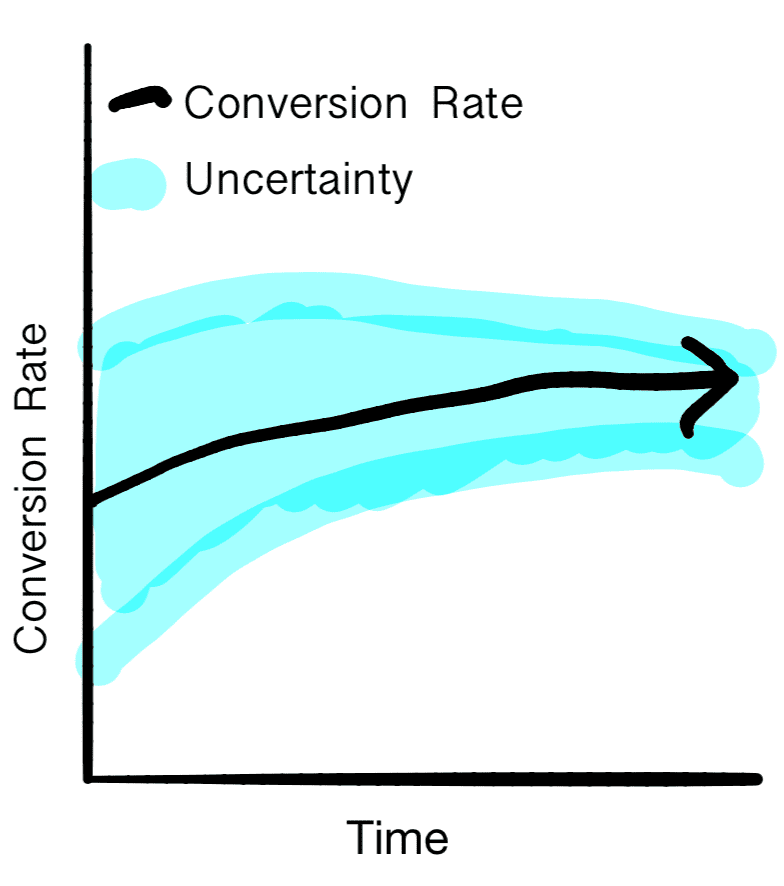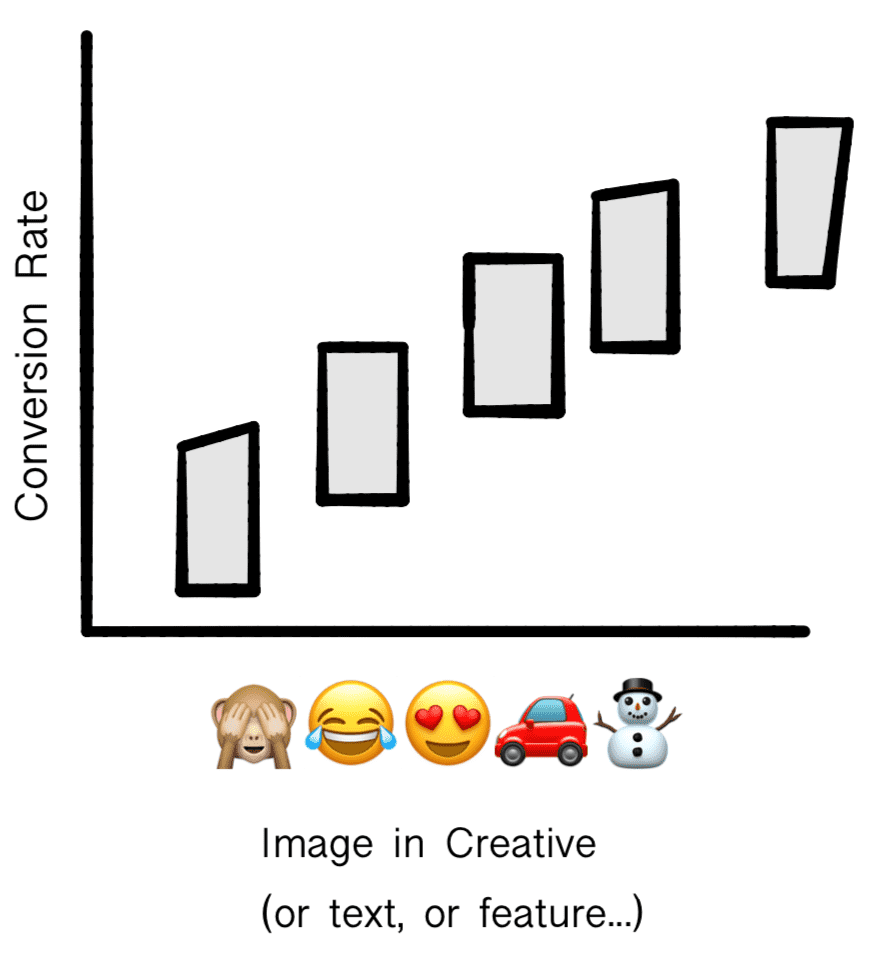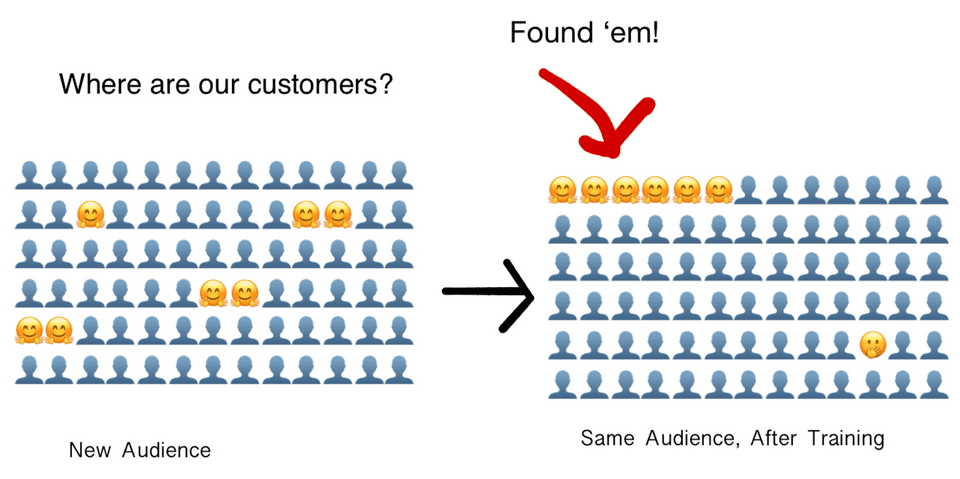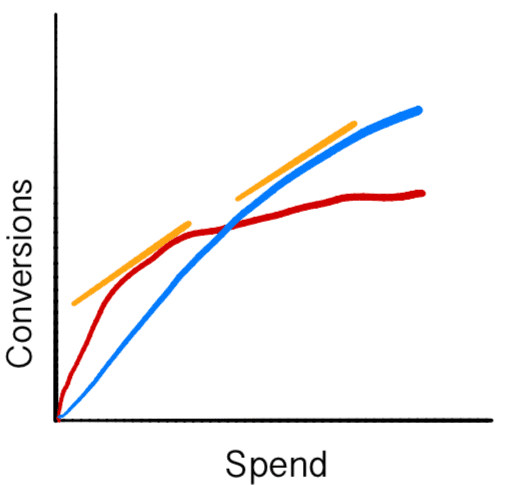How do marketing campaigns improve over time?
The goal of any performance marketing campaign is to maximize some conversion objective while minimizing spend for that objective.
Performance on a typical campaign tends to follow a ∩-shaped curve:
- Bootstrapping and learning. Starting from “cold.” Depending on our product and what in the funnel we’re optimizing for, it can cost hundreds or even thousands of dollars to get our first conversion.
- Optimizing. Performance is improving over time. CAC remains approximately stable or improves with increased budget.
- Oversaturation and frequency caps. We’ve achieved world domination. Our creative is getting tired, our audiences are tapped out, CAC is rising. Time to start over with fresh audiences and new creative!
Great optimization, gradual creative refreshes, and good audience architectures allow us to lets us hit our stride faster and longer.
So how do we optimize a campaign? Here are 7 ways:
Conversion Rate Improvements
As a well-executed marketing campaign evolves, conversion rates in the campaign will tend to improve—starting low and ending at some saturating point—and become more predictable as a a marketing stack learns to offer the “right ad to the right person at the right time,” and direct them into the right funnel.
Given a set of ad creative and audiences, these improvements describe how a marketing tech stack will converge to the “right ad, right person, right time.”
Choosing Better Ad Creative
Suppose you launch a campaign with 7 different images (or text, or any other feature). Over time, you’ll learn that a few of these images are consistent overperformers, a few of them are consistent underperformers, and a few are indistinguishable from average. By allocating more spend on the better performing creative,
It has been my experience that excellent creative can attract the right audience to the top of the funnel, but has a smaller effect than audience on likelihood to convert. By the time you clicked on an ad (an image of a motorcycle), decided you wanted to purchase (a motorcycle), and checked out, you probably forgot about the original ad you saw relative to your audience (bike-curious). The right creative won’t win you a customer, but the wrong creative will lose a prospect.
Choosing Better Audiences
As with creative, you should expect some of them to overperform, some to perform indistinguishably from average, and some to underperform. As discussed above, great audiences tend to be great throughout the funnel, and poor audiences tend to be poor throughout the funnel.
Better Audience Performance
As an audience matures, it starts to learn which prospects are more likely to convert. You can think of training an audience as a kind of sort. At the beginning, we can sample users from an audience at random. Over time, we understand the thousands of factors that might make a user in an audience more likely to convert and be able to estimate . If an audience were a deck of cards, we’d start with a fully shuffled deck, and end up with our aces on top, followed by our face cards and ending with our threes and twos.
Improved Intermediate Steps
With more traffic coming from the top of the funnel, you can run higher-volume A/B tests in the middle of your funnel—testing different copy, images, or even completely different funnels—and ultimately improve the conversion rate from one step of the funnel to the next.
Optimization Event Improvements
The optimization event is the step in your funnel you are trying to win the most of from a set of users. If you’re shooting hoops, your optimization event is a making a basket whenever you shoot. If you’re running an campaign for the very first time, your very first optimization step might be getting someone to click on your ad.
There’s a reason why basketball players will frequently practice from the free throw line instead of half-court. If you make it one out of every five shots, you’ll what works and what doesn’t faster than if you only make one out of twenty.
The same is true in digital advertising. If you start a new campaign with a low budget, and attempted to optimize deep in the funnel, it will take a long time for the campaign to get the right idea of what works. It’s shooting from half-court.
Of course, you don’t want to optimize for the top of the funnel forever. It is easy to get cheap, uninterested traffic for almost anything—and if you only optimize for the top of the funnel, you’ll get a better and better idea of this, at the expense of learning what drives the acquisition event you actually want. To use the basketball example, if you only ever practiced from directly under the basket, you would probably get a misleading idea of how to shoot baskets generally.
So, how deep should you optimize your funnel? Facebook recommends optimizing for “a conversion that occurs at least 100 times a month without running any ads.” The more conversion events you get deeper in the funnel, the deeper in the funnel you can optimize.
There is an important caveat here, and that is related to your customer close cycle. Facebook optimizes for one-day post-click conversion events. If your ultimate conversion event happens several days after the customer initially experiences your ad, you risk optimizing your ads extremely slowly, or suffering high-variance delivery of ads.
New Audience Improvements
The audiences you target today will one day run out. The audience members likeliest to convert will become overexposed to your ads, and costs will rise.
That’s why finding ways to identify and sell to customers that aren’t like your current beachhead audiences is so important.
Channel Improvements
More Channels
Starting and optimizing more channels gives you more places to allocate your money. This can happen because a channel that works great at 100,000/month or $1,000,000/month. If you have success across several channels that are successful with different user bases, you can allocate more money and slow the diminishing marginal returns.
You also enjoy more performance stability. Just like in finance, the more channels you have with uncorrelated costs, the less variance in performance you should expect. If the cost on one channel goes up, you can shift those dollars to a different channel until pricing falls or you eek out better performance.
How much do you allocate between channels? One way is to allocate until the conversions per dollar is the same across channels:
In this (very) crude drawing, you can see the conversions go up with spend—but at a slower and slower rate. The orange lines indicate where the slopes of these curves are the same. That’s where you allocate your spend. (Generating these curves? A much harder proposition.)
Better Bid Discipline
With more channels and a better ability to predict conversion and LTV, you can be more disciplined about what you’re willing to bid on any one channel.
Generative Improvements
As a campaign progresses, an organization’s internal generative capabilities—creating and testing new creative, audiences, or questions—improves as its understanding of the customer and the value prop improve. I call these “generative improvements,” because they relate to our ability to generate new marketing assets that are likely to work.
Creative Generation
At the beginning of a product, company, or campaign, marketers will paint with a broad brush—sampling lots of copy, images, positioning, etc.
Over time, a brand solidifies, and campaigns coalesce around the advertising themes that drive performance. An idea—hopefully an accurate one—of what will resonate with an audience and what won’t, and what is “on brand” and what isn’t—will emerge and evolve.
Segment Generation
Segmentation generally only makes sense if you have reason to believe that one segment of people are worth bidding a different amount for, or that they would respond to a different set of creative.
Remarketing is a great example of this. Cart abandonment ads make sense because:
- Bid: They’re worth more money. they’ve already invested in your service and abandoned their cart.
- Creative: A “come back to us” promotion, or a reminder of the items in their cart, might make a lot more sense for this group than your average top-of-funnel consumer.
A few segments that might justify different creative or bids:
- Small businesses versus enterprises
- First-time customers versus repeat customers
- Free customers versus paid customers
- Customers who have referred other customers versus those who haven’t
- Customers who have churned versus those who haven’t
- Time-based cohorts
Over time, larger traffic streams and a larger customer base creates more opportunities to segment users into new audiences.
Question and Experiment Generation
More data allows a marketing organization to test more things—and better things—at once, as well as ask better questions.
Customer Data Improvements
The deeper in the funnel you go, the more customer behavior data you have. This also includes information on customer churn, expansion, and referrals.
I call this the rows into columns problem. At the top of the funnel, you have relatively little information (few columns) on a large number of users (rows). As you go deeper into the funnel, you have incredibly rich customer behavior data (columns) on comparatively few users (rows).
The deeper you go into the funnel, you trade rows (many records) for columns (richer records).
Better Customer LTV Modeling
You can use this data to create more accurate customer lifetime value models, and use that data to improve your bids accordingly. A free customer may have a different expected LTV from a paid one, and a
Better Segmentation and Persona Data
With richer data, you can better segment customers into new lookalike audiences and create new personae.
Organizational Improvements
The Marketing Team in the Organization
As a marketing team continues to improve, it has the opportunity to become more deeply interdependent with other parts of the organization. Marketing may come to count on the product organization to improve growth initiatives; product may come to count on marketing for activation support; each may count on the other for customer insights.
Team Improvements
Like any team, a marketing organization will improve the quality and velocity of its output as it advances through the Tuckman “forming,” “storming,” “norming,” and “performing” stages of team development. Trust builds; norms, roles, and processes solidify; mistakes are learned from.
Individual Improvements
Finally, each individual team member should be improving their own mastery of skills and abilities, using experience and feedback to improve their craft, and using the knowledge of the team to develop a better understanding of how their output fits into the broader picture of the work being done.





